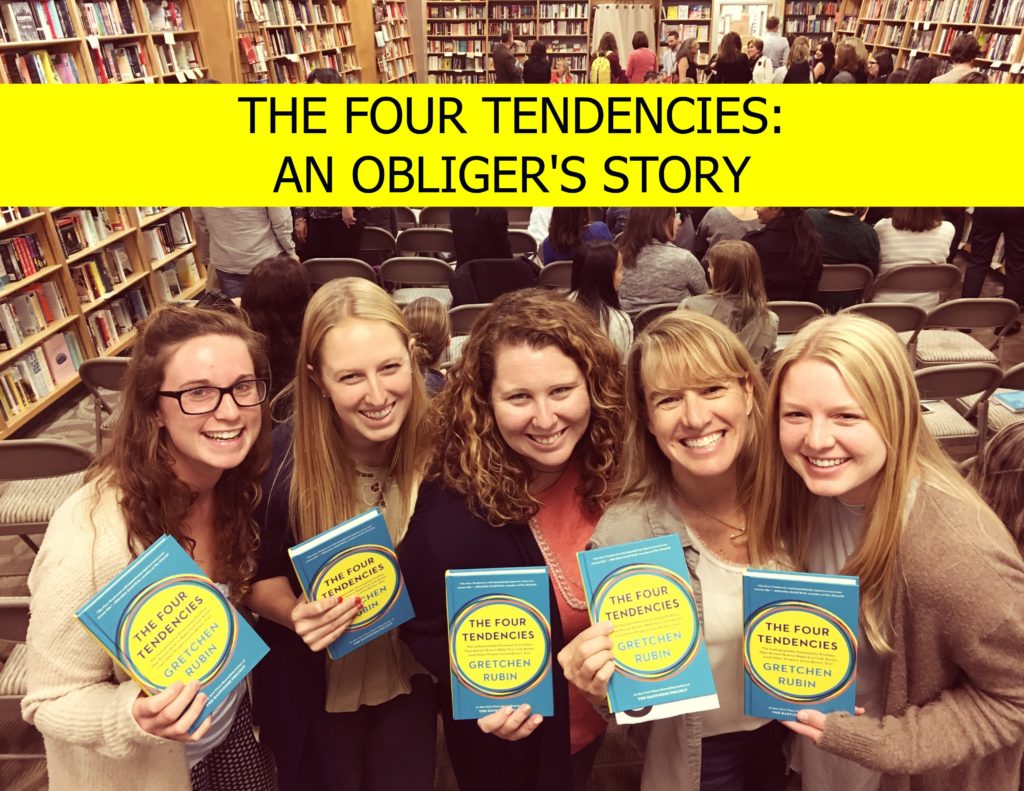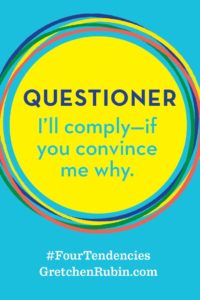The Four Tendencies: An Obliger’s Story

I’ve been enjoying Gretchen Rubin’s books since my oldest daughter (also named Gretchen) gave me The Happiness Project (Revised Edition): Or, Why I Spent a Year Trying to Sing in the Morning, Clean My Closets, Fight Right, Read Aristotle, and Generally Have More Fun several years ago. I listen to Rubin’s podcast (Happier) and subscribe to her emails. Being the superfan that I am, I preordered her latest book,The Four Tendencies: The Indispensable Personality Profiles That Reveal How to Make Your Life Better (and Other People’s Lives Better, Too)
, so that it would be delivered the day it was released (September 12).
My own research in positive psychology has confirmed what Rubin communicates so clearly in her books: the better we know ourselves, the more likely it is that we will have stronger, more long-lasting relationships with others and accomplish our goals, both of which are happiness boosters in life.
When I heard that Rubin was coming to San Francisco on her book tour, I recruited a team of my favorite readers to join me for a road trip. If you know how much I love my sleep (and how being in bed with a book by 9:00 p.m. is pretty much my perfect evening), you’ll know that it was a BIG DEAL for me to take a 3½ hour road trip (each way!) from my home in Central California for a 7 p.m. event in San Francisco. As I told you, this is superfan status we’re talking about here. My co-participants weren’t as familiar with Rubin’s work, but they were all game for an adventure.
Needless to say, I was not disappointed. I had finished reading the book in the early morning hours the day of the road trip. (You’ll find out later why knowing that I was going to the book signing made me finish the book really fast, right at the deadline.)
I was already feeling like a mini-expert on the Four Tendencies before I headed out the door the morning of the book signing.
The Four Tendencies




If you’re not familiar with Rubin’s Four Tendencies framework, she’s given millions of people her quiz to determine their tendency: Upholder, Obliger, Questioner, or Rebel. These designations explain just one aspect of personality: how one responds to inner and outer expectations. Says Rubin, “The Four Tendencies explain why we act and why we don’t act.”
Rubin first wrote about these tendencies in her book Better Than Before: What I Learned About Making and Breaking Habits–to Sleep More, Quit Sugar, Procrastinate Less, and Generally Build a Happier Life (also an excellent read) while explaining different strategies to help people form new habits. No strategy works for everyone, and delving into the different ways people respond to expectations provides Rubin’s framework for why people need different strategies to make positive changes.
Rubin created the quiz and framework, and wrote The Four Tendencies to, as the cover states, “reveal how to make your life better (and other people’s lives better, too).”
Before you read further, pop over to Rubin’s website and take the quick quiz. But don’t get side-tracked over there. Come back! My story will make more sense to you after you know your own tendency. Or, if you know you’ll get side-tracked (there’s a ton of good stuff on her site), keep reading and take the quiz later.
Probably the biggest “aha!” moment I had when reading the book is explained here — “With wisdom, experience, and self-knowledge from the Four Tendencies, we can use our time more productively, make better decisions, suffer less stress, get healthier, and engage more effectively with other people.”
Understanding that other people’s tendencies cause them to think and respond differently than we do can help us have more tolerance for those differences and better understand how to communicate with them. Instead of wondering why the heck someone did or didn’t do something the way we would have, we can figure out a better strategy to work with them based on their tendency.
An Obliger’s Story
People who know me might assume I’m an Upholder like my husband. My friends know that I’m a hard worker who always has a new project going on. I run a business, have five kids, and I’ve run several marathons. I usually have several things I’m working on, and I’m dependable about getting things done quickly and well.
But what people who don’t live in my brain (i.e., everyone but me) don’t know is the way I have learned to trick myself to get things done. Before reading this book, I didn’t have a name for why I can’t just do something just because I decide I want to to do it. Instead, I need some specific guidelines in place. Hard deadlines work well for me, and I thrive in classes, groups, and with coaching.
But Rubin’s description of my Obliger tendency created countless lightbulb moments where I see why I haven’t been able to do certain things I’ve wanted to do and also how I’ve learned to hack my tendency in some cases.
Now that I understand my tendency even better, I know the strategies for how to get myself to do things, even those things I’ve frustrated myself by not doing or following through on for many years. If you’re an Obliger, too (we’re the biggest group), you’ll be able to relate to my experiences.
But before I tell my Obliger story, let me take a quick side trip to a funny Upholder story.
My daughter and I were heading to Rubin’s San Francisco event right after a haircut appointment, so we drove there together. She was driving. When we pulled into the parking lot, I said, “Just pull up to the curb, and I’ll drop you there.” (I was getting a coffee while she had her appointment, then coming back to get her.)
Her response: “But it’s a red curb, a fire zone.”
Having just finished the book that morning, I laughed and said, “That is such an Upholder response!”
What I’ve always called being an extreme rule follower is actually one of the common traits of Upholders. To my Upholder daughter, a red curb means absolutely you do not ever park there, even if it’s for the 20 seconds it takes for me to go around to the driver’s side and pull away.
Now, I’m a rule follower, too, but not quite to that extreme. Since we weren’t parking the car there and there was no imminent fire, I felt it was fine to stop there for a moment.
“Knowing other people’s tendencies also makes it much easier to persuade them, to encourage them, and to avoid conflict.” –Gretchen Rubin
Here-in lies the crux of why understanding these tendencies is important: we often can’t understand why people don’t see things the same way we do, because to us it’s so obviously one way. But when we understand their tendency, responses that once confounded us become more clear. Most importantly, once we understand our children and our spouse’s tendencies and how those tendencies interact with our own, we are able to get along better with the people we love (and help them get things done)!
People who have a different tendency than you likely do not see things — like a red curb — the same way you do. I’ve taken the liberty of outlining what people of different tendencies might think about parking at a red fire curb (Rubin may want to correct me if I’m off base here):
An Upholder will not park at the red curb.
An Obliger will not park there, either, but may stop briefly to drop someone off.
A Questioner might look around and question why there’s so much red curb, determine that the length of the red curb is arbitrary, reason that a fire truck would have plenty of space even if he is parked there, and park on one end of the red curb, leaving space for the fire truck.
Finally, a Rebel may just go ahead and park there because they simply don’t like anyone telling them where to park.
I know the Upholder tendency well, because in addition to having an Upholder daughter, I’m also married to one. (Perhaps there’s a genetic component to these tendencies? Maybe Rubin will investigate!) My Upholder husband, who consistently gets up at 5 a.m. to exercise every single day and who has eaten about 10 grams of sugar in the past two years has, at times, by no fault of his own, made me feel like a lazy slob.
I just can’t keep up with things — even things I really want to do — just because I want to do them. I tend to do things in spurts, start things I don’t finish, and I have difficulty sticking with habits consistently.
Knowing my Obliger tendency, I now understand how I’ve managed to do certain important things. To get myself to run a lot of miles, I sign up for a race and print out a training plan. Once I have a date on my calendar and know that I have a race coming up, I train. Being an Obliger, I know that once I’ve committed to something, paid for it, and possibly even asked a friend to sign up to run with me, I will of course do it.
After reading Rubin’s book, I know why signing up for a race doesn’t work for everyone. Questioners and Rebels require different hacks to get themselves to train for a marathon.
For me, once a race is over, my running is pretty much done until I sign up for another race. And, so, for more than a decade, I kept up my good running habit by always having a race on my calendar. I didn’t realize it, but I had tricked my Obliger self into being a consistent runner. I like running and enjoy it once I’m out there on the trail, but to get myself out there, I need a race and a plan.
This year, I had a knee injury from a fall on some ice, and I haven’t signed up for any races since February. Guess what’s happened to my running? You got it! I’ve become a walker now (until I sign up for another race, that is)!
My best Obliger hack ever happened at the start of this year. I had spent last fall writing a parenting book I’ve always wanted to write about lessons I’ve learned from my years at camp. I gave myself a significant upcoming birthday (I turned 50 in February) as a deadline. When December rolled around, I had a lot of words written. My birthday was two months off, and I was really rolling on my goal.
But I wasn’t sure what to do next, and I feared that this would be another one of my almost-finished projects that fizzled out. For a few weeks, I browsed the internet learning about publishers, agents, and different publishing options, trying to figure out how to actually finish my book.
I stumbled upon the website of a book coach (something I had never heard of) and contacted her. As an early birthday gift to myself, I purchased a consultation with Jennie Nash. She ended up taking me on as a client in January, and we started working together.
Jennie reviewed some sample chapters I had written, as well as the draft of my book proposal. She was really encouraging and said it was a good start to a great book, but I still had a lot of work to do.
And so began my work with my new book coach! Starting in January, Jennie gave me weekly deadlines that included not only the writing, but also tasks related to publishing and marketing the book, like reviewing lists of potential agents. We’d have a call scheduled a few days after each deadline to discuss whatever I’d turned in, her edits, and next steps in the publishing process.
By April, I had an 85-page, polished book proposal (including an introduction and two chapters) to send to potential agents.
By May, I had an agent, and — as I write this post — my agent is working out the details on a publishing contract.
After reading The Four Tendencies, I now understand why hiring Jennie was the key ingredient to completing my book project. As an Obliger, I most likely would not have followed through with all of the steps needed to actually get this book published without adding the external expectations of specific deadlines planned by a knowledgeable person.
Also, due to some of my other non-tendency related personality traits (including a bit of a perfectionism issue), I am inclined to over-edit and never think things I write are “finished.” By hiring Jennie and being required to send her chapters (some of which I sent with caveats about how they “weren’t really done” and “I didn’t have enough time”), I created the structure I needed to complete something I’ve wanted to do for years.
Paying a book coach to help me with my project seemed a bit superfluous back in January, but after reading The Four Tendencies, I understand more clearly why Obligers like me need a coach or class that creates specific deadlines. My internal expectations alone wouldn’t have been sufficient to get the book completely done.
I always excelled at school, and I now understand it’s because of the teachers and deadlines. I readily meet outside expectations, and I do my best work when I have a clearly charted project list with due dates. In my job as a camp director, we use a project management software called Basecamp to create projects and to-do lists that keep us on track. Most of us are Obligers, so I see why specific deadlines and accountability are important. When we go too long at work without having a meeting or updating our assignments, projects start to languish.
Equally valuable to learning about our own tendency are Rubin’s insights about relating to and communicating with people who have a different tendency from our own. Subheadings like “Dealing with a Rebel Spouse” as well as her final chapters on “When the Four Tendencies Pair Up” (strengths and pitfalls of different tendency pairings) and “Speaking Effectively to Each Tendency” have the potential for saving marriages and work relationships, not to mention helping in our work with children either as parents, teachers, or camp professionals.
I highly recommend reading The Four Tendencies. I’m sure — like me — you’ll have many lightbulb moments about yourself, your family members, and the people you work with!
And, maybe you’ll even learn how to do something you haven’t been able to do before – like write a book!
P.S. I’ve had a few people ask about my book coach. Jennie offers classes and has a coaching business at Author Accelerator. I highly recommend her services if you want to write or finish a book!
